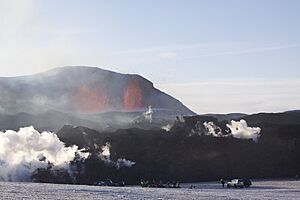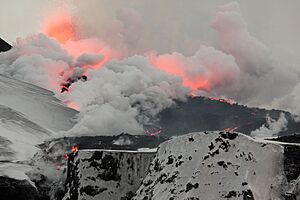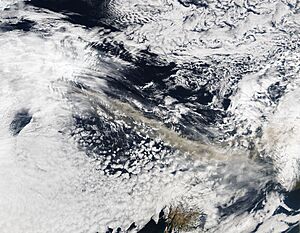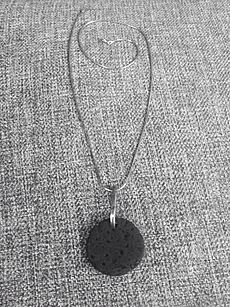2010 eruptions of Eyjafjallajökull facts for kids
Quick facts for kids 2010 eruptions of Eyjafjallajökull |
|
|---|---|
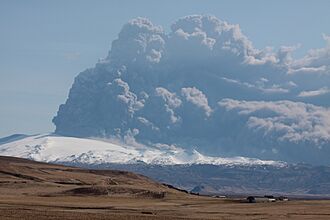
Volcano plume on 18 April 2010
|
|
| Volcano | Eyjafjallajökull |
| Type | Strombolian and Vulcanian eruption phases |
| Location | Southern Region, Iceland 63°36′N 19°36′W / 63.6°N 19.6°W |
| VEI | 4 |
| Impact | Large-scale disruption to air travel, smaller effects on farming in Iceland |

Composite map of the volcanic ash cloud spanning 14–25 April 2010
|
|
Between March and June 2010, a series of volcanic events happened at Eyjafjallajökull in Iceland. These events caused huge problems for air travel across Western Europe.
The main problems started in April 2010 and lasted for six days. Smaller issues continued into May, and the volcano kept erupting until June 2010. The eruption was officially over in October 2010. This was after three months of quiet, when snow on the glacier stopped melting. From April 14 to 20, ash from the volcano covered large parts of Northern Europe. About 20 countries closed their skies to planes. This affected around 10 million travelers.
Small earthquakes began in late 2009 and grew stronger. On March 20, 2010, a small eruption began. It was rated as a 1 on the Volcanic Explosivity Index (VEI).
On April 14, 2010, the eruption became much stronger. It created a huge ash cloud. This led to most of Europe's airspace being closed from April 15 to 20. Many flights in, to, and from Europe were cancelled. This caused the biggest air travel problems since World War II. This second phase of the eruption shot out about 250 million cubic meters of rock and ash. The ash cloud rose about 9 kilometers (5.6 miles) high. This made the eruption a VEI 4. By May 21, 2010, this strong eruption phase had calmed down. No more lava or ash was being produced.
By June 6, 2010, a small, new opening appeared on the side of the main crater. It was shooting out small amounts of ash. Scientists kept watching the volcano closely. In October 2010, a scientist named Ármann Höskuldsson said the eruption was officially over. However, the area is still warm underground and could erupt again.
Contents
Understanding the Volcano
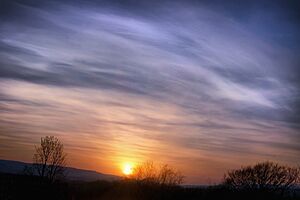
Eyjafjallajökull (say it like: AY-yah-fyat-lah-YO-koot-l) is one of Iceland's smaller ice caps. It is in the far south of the island. This ice cap covers a volcano that is 1,666 meters (5,466 feet) high. This volcano has erupted many times since the last ice age. Big eruptions happened in 920, 1612, and from 1821 to 1823. Past eruptions of Eyjafjallajökull have sometimes been followed by eruptions at its larger neighbor, Katla.
The volcanic events that started in March 2010 were seen as one eruption with different stages. The first stage released molten rock (lava) that flowed from the volcano's sides. This was a gentle, effusive eruption. Not much ash was thrown out during this stage, only rising about 4 kilometers (2.5 miles) into the air.
However, on April 14, 2010, the eruption became much more powerful. This was an explosive eruption. It shot fine, glass-filled ash more than 8 kilometers (5 miles) into the air. This second stage was rated as a VEI 4. This is a large eruption, but not the most powerful possible. For example, the 1980 eruption of Mount St. Helens was a VEI 5. The 1991 eruption of Mount Pinatubo was a VEI 6.
This volcanic activity caused huge problems for air travel for a few reasons:
- The volcano is right under the jet stream. This is a strong wind current high in the atmosphere.
- The jet stream was blowing steadily southeast during the eruption. This carried the ash over Europe.
- The eruption happened under 200 meters (656 feet) of glacier ice. The melting ice flowed into the volcano.
- This quickly turning water into steam made the eruption much more explosive.
- The hot lava cooled very fast, creating a cloud of sharp, glass-filled ash.
- The volcano was powerful enough to shoot ash directly into the jet stream.
Watching the Volcano
Many people wanted to see the volcano. Local tour companies quickly started offering trips to see it. The Icelandic Police told people where they could go safely. They also had teams from the Icelandic Association for Search and Rescue at the site. These teams helped keep people safe and made sure they stayed out of dangerous areas.
Companies like Vodafone set up webcams. These cameras showed live views of the eruption from different places. One camera even had a special heat-sensing view.
Scientists Study the Eruption
Scientists from the London Volcanic Ash Advisory Centre (VAAC) helped predict where the ash would go. They made maps showing the ash cloud over the North Atlantic.
A study in December 2009 showed that there were more earthquakes around Eyjafjallajökull. This was happening between 2006 and 2009. In 2009, there were 200 earthquakes in just a few months. Most of these were deep underground, about 8 to 12 kilometers (5 to 7.5 miles) below the volcano. In late 2009, thousands of small earthquakes began. They were about 7 to 10 kilometers (4 to 6 miles) deep.
The radar stations in Iceland did not see much ash falling at first. But on March 22, they reported ash falling in areas northwest of the eruption. Cars were covered with a thin, grey layer of ash. An explosion that day sent ash 4 kilometers (2.5 miles) high. On March 23, hot magma touched snow, causing a steam explosion. This sent a cloud 7 kilometers (4.3 miles) high. Many more steam explosions happened after that.
By March 26, 2010, special GPS equipment showed that the ground near the volcano had moved 3 centimeters (1.2 inches) south. This movement meant that molten rock (magma) was flowing into the volcano's magma chamber. This pressure caused the ground to shift. Earthquakes continued to increase. From March 3 to 5, nearly 3,000 earthquakes were recorded. Most were too small to feel, but some could be felt in nearby towns.
Closing European flights also helped reduce carbon dioxide (CO2) in the air. Planes would have released about 344 million kg of CO2 per day. The volcano released about 150 million kg of CO2 per day.
First Stage: Lava Flows
The first stage of the eruption lasted from March 20 to April 12, 2010. During this time, lava flowed from different openings on the mountain's sides.
People Had to Leave
About 500 farmers and their families had to leave their homes overnight. Flights to and from Iceland's main airports were delayed. But by the evening of March 21, flights were allowed again. People were allowed to go back to their homes after a meeting with the police. Roads near the volcano were closed for safety. This was because of the danger of flash floods if the lava melted a lot of ice. But the roads were later reopened.
Changes in the River
On March 22, a device in the Krossá river showed a sudden rise in water level and temperature. The water temperature went up by 6 degrees Celsius (10.8 degrees Fahrenheit) in two hours. This had never happened so fast before. This was likely due to the eruption nearby. The Hruná river, which flowed into the lava, was recorded at 50 to 60 degrees Celsius (122 to 140 degrees Fahrenheit). This showed the river was cooling the lava.
Cracks in the Ground
The first stage of the eruption began late on March 20. People first saw a red cloud at 11:52 PM GMT. It was lighting up the sky above the eruption site. Before the eruption, there were many earthquakes and the ground was changing shape. This meant magma was moving inside the volcano.
A crack, called a fissure, opened up. It was about 150 meters (492 feet) long. Ten to twelve lava craters were shooting lava up to 150 meters (492 feet) into the air. The lava was about 1,000 degrees Celsius (1,832 degrees Fahrenheit). It was thick and flowed slowly. The molten lava flowed more than 4,000 meters (13,123 feet) into a canyon. It formed a lava fall over 200 meters (656 feet) long.
On March 25, scientists saw something new. They saw a "pseudocrater" form during a steam explosion. This was the first time this had been seen. The ground continued to expand for two days after the eruption started. This meant that magma was flowing into the volcano's chamber at about the same rate it was erupting.
A new fissure opened on March 31. It was about 200 meters (656 feet) northwest of the first one. Many people saw it open. This new crack was smaller, about 300 meters (984 feet) long. Lava from it flowed into another canyon. Scientists said both cracks were fed by the same magma chamber. No new earthquakes were felt when the second crack appeared.
A scientist named Magnús Tumi Einarsson said this eruption was small compared to others, like the Hekla eruption in 2000. The eruption was happening in a mountain pass, not under the main glacier. This meant less risk of big floods. However, if the crack spread into the ice, the risk of flooding would greatly increase.
Second Stage: Explosive Eruption
After a short break, the volcano became very active again. Early on April 14, 2010, new craters opened under the volcano's ice-covered top. Meltwater started flowing from the ice cap around 7:00 AM. Soon, a huge eruption cloud was seen. An airplane from the Icelandic Coast Guard used radar to see the erupting craters. Meltwater flowed down both sides of the volcano. An ash-filled cloud rose more than 8 kilometers (5 miles) high. Strong winds blew it to the east.
How Farming Was Affected
The Icelandic Food and Veterinary Authority told all horse owners to watch out for ash fall. If a lot of ash fell, horses had to be brought inside. The thick ash layer on some farms became wet and heavy. This made it very hard to farm or feed livestock.
What Happened During the Second Stage
Unlike the first stage, this second stage happened under glacier ice. The cold water from the melted ice quickly cooled the lava. This made the lava break into tiny, sharp glass pieces. These glass particles were then carried up into the ash cloud. This, along with the eruption's strength (VEI 4), sent a glass-rich ash cloud into the jet stream. This eruption was 10 to 20 times larger than the first one.
Volcanic ash is very dangerous for airplanes. The tiny glass particles can scratch windows and melt in hot jet engines. This can damage engines and make them stop. Many flights in Europe were cancelled after April 14. No commercial planes were damaged, but some military planes had engine problems. The ash cloud's location depended on the eruption and the winds. Most of the ash was carried by winds over Europe, causing many countries to close their airspace. This also affected the economy and events across Europe.
Third Stage: Going Quiet
By May 24, 2010, webcams showed only a cloud of water vapor. There was also a bluish haze from sulfur gases. A lot of dry ash was on the ground. When the wind blew, it created an "ash mist." This made it hard to see the volcano.
On June 21, 2010, scientists saw that earthquakes in the area were getting weaker and happening less often. In October 2010, a scientist from the University of Iceland said the eruption was officially over. However, the area is still warm underground and could erupt again.
During the eruption, TV news reporters often just called it "the Iceland volcano." They did not try to say "Eyjafjallajökull."
Health Effects
No one died because of the 2010 Eyjafjallajökull eruption. People who lived near the volcano had more irritation in their eyes and throats. But their lung health was not worse than expected. Six months later, people in the area still had more breathing problems than a group from North Iceland where no ash fell. In Scotland, there was no big increase in calls to health services for breathing or eye problems.
How Ash Affected Air Travel

Volcanic ash is very dangerous for airplanes. Smoke and ash make it hard for pilots to see. Tiny pieces of ash can scratch plane windows. They can also melt in the hot engines of planes, causing damage and making the engines stop. Many flights in Europe were cancelled after April 14, 2010. No commercial planes were damaged, but some military planes had engine problems. The ash cloud's location depended on the eruption and the winds. Most of the ash was carried by winds over Europe. This led to the closing of airspace over much of Europe. This closure had a big impact on the economy and cultural events across Europe.
Other Effects
At the volcano's opening, the gases, ash, and cloud created a rare weather event called "volcanic lightning." This is also known as a "dirty thunderstorm." When rocks and other things flying out of the volcano hit each other, they create static electricity. This, along with the ice at the top, helps create lightning.
Some past eruptions in Iceland, like from the Hekla volcano, released a lot of fluoride. This can be dangerous for animals, especially sheep, if they eat too much ash. In 1783, most of Iceland's sheep died from fluoride poisoning after the 1783 eruption of Laki. The ash from the Eyjafjallajökull eruption had less fluoride. It had about one-third of the amount found in Hekla ash.
As of April 15, the eruption was not big enough to change global temperatures. Some past eruptions, like Mount Pinatubo, were much larger and affected the world's climate. One past eruption of Eyjafjallajökull, starting in 1821, lasted over two years. But usually, major eruptions only last a few days.
Comparing to Other Eruptions
The Eyjafjallajökull eruptions and its ash cloud were not the biggest ever. However, its location was key. It caused problems for air travel across Europe. Neither stage of the eruption was unusually powerful. For example, the Mount Pinatubo eruption in 1991 was a VEI 6. That eruption lasted eight days. Its ash cloud caused unusual weather and a drop in global temperature for years. But the second stage of Eyjafjallajökull's eruption lasted longer than Mount Pinatubo's.
See also
- 2010 eruptions of Mount Merapi
- 2014–2015 eruption of Bárðarbunga
- Air travel disruption after the 2010 Eyjafjallajökull eruption
- British Airways Flight 9
- Effects of the April 2010 Eyjafjallajökull eruption
- KLM Flight 867
- Laki
- List of volcanoes in Iceland
- North Atlantic oscillation
- Timeline of volcanism on Earth
- Tuya


